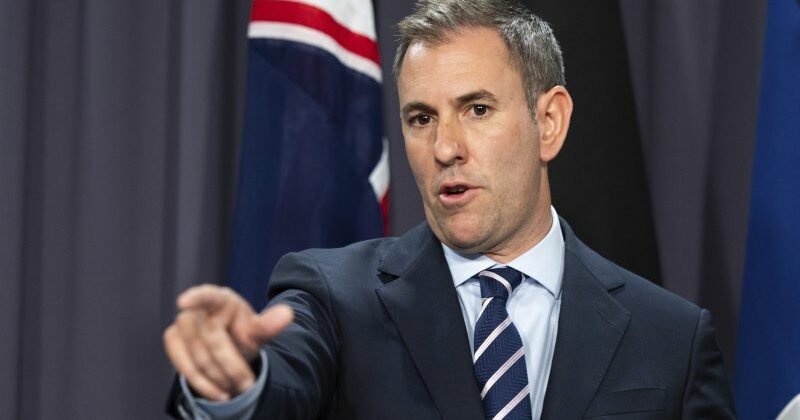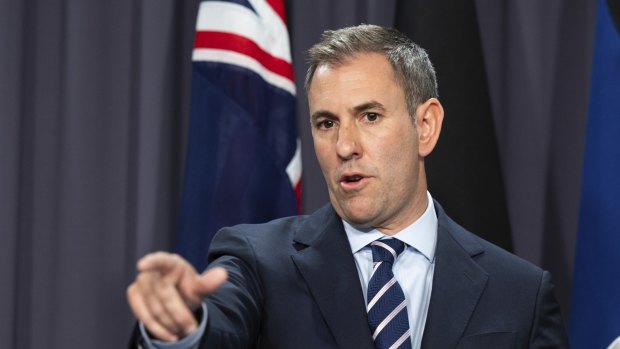Save articles for later
Add articles to your saved list and come back to them any time.
Treasurer Jim Chalmers has signalled huge new public investments to slash Australia’s greenhouse gas emissions while modernising the national economy to take advantage of advances in renewable energy, minerals and manufacturing.
Chalmers, speaking at The Australian’s Economic and Social Outlook Conference in Melbourne on Thursday morning, said the government was developing a “uniquely Australian” approach to lifting investment that would underpin economic change similar to that the country went through in the 1950s and 1980s.
Treasurer Jim Chalmers has used a speech to reveal plans to modernise the Australian economy to deal with plans to cut greenhouse gas emissions.Credit: Alex Ellinghausen
Governments around the world are ramping up public investment in renewables and the electrification of their power systems as part of the effort to reach net zero emissions by 2050.
This week, the International Monetary Fund used a report on Australia to argue that if the country did not introduce a carbon price to drive emissions reductions, it should use “strong sectoral policies” including public investment.
Chalmers said the government was already investing $40 billion into making the country a renewable energy superpower but more money, both private and public, would be necessary to undertake the type of change required to meet Australia’s emissions objectives.
More investment would also be necessary to ensure Australia took advantage of its own unique advantages in areas such as critical minerals or the development of green metals.
“While important building blocks are now in place and progress has been made, we will need to do even more to secure sufficient renewable energy generation, transmission and storage to meet our ambitions,” he said.
A key driver of international investment in renewable energy and new manufacturing has been America’s Inflation Reduction Act, which some analysts believe could funnel up to $US1 trillion into new US-based industries.
Chalmers said while America’s actions were substantial, the government was developing a policy agenda that reflected Australia’s own advantages.
“We will complement, not copy, the priorities and plans of other nations, not just do exactly the same kind of investment with the exact same subsidies,” he said.
“We won’t realise Australia’s unique geographical, geological, geopolitical, intellectual and meteorological advantages by designing an Inflation Reduction Act Lite – looking only for big numbers but missing the bigger picture.
“Our plan will be ambitious, but uniquely Australian – focused on Australia’s strengths, on renewable energy, resources, our reputation as a trusted and reliable trading partner, on our people, and our knowledge.”
Chalmers said the government was not just looking to pump cash into new industries.
He said a skilled workforce, support for untested technologies and the strengthening of supply chains would all play a critical part in transforming the economy.
A more active industry policy to support net zero would be driven by a new approach to decision-making.
Incoming Productivity Commission boss Danielle Wood will oversee a new statement of expectations for the institution to focus, in part, on the economic ramifications of net zero.Credit: Elke Meitzel
“To make it very clear, in making decisions about net zero industry policy we will now be guided by these tests: Whether Australia can be competitive in the industry, by leveraging and building up our comparative advantages, whether it contributes to an efficient and orderly pathway to net zero, whether it builds the capabilities and resilience of people and regions,” he said.
The Productivity Commission, which will soon be headed by economist Danielle Wood, will be a part of the new approach to industry policy and dealing with net zero.
Chalmers said a new “statement of expectations” for the commission will be established that will make clear the institution will have a focus on a successful net zero transformation of the Australian economy.
Start the day with a summary of the day’s most important and interesting stories, analysis and insights. Sign up for our Morning Edition newsletter.
Most Viewed in Politics
From our partners
Source: Read Full Article


